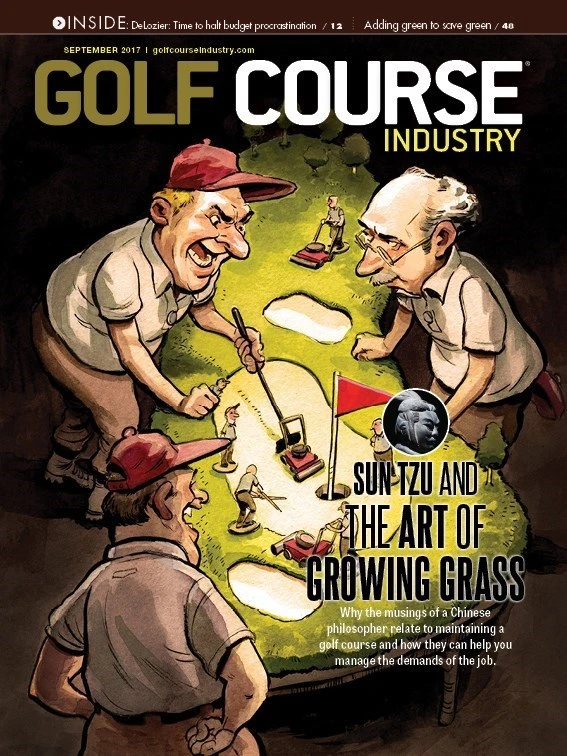
Summer can be tough on golf courses. Heat, pests, drought, excessive foot traffic—all these things can stress turf and negatively impact its health and appearance. Now that cooler fall weather has arrived, it’s the right time to get your golf course back in shape for next spring, and that includes applying the right fertilizer at the right time. However, with so many fertilizers on the market today, it can be tough to know which option is best for your course.
“Today, the emphasis is more toward the gradual release of nutrients for golf course turf throughout the year, with some northern golf course superintendents experimenting with fall fertilization as their primary fertilizer application,” says Chris Derrick, technical agronomist with Koch Turf & Ornamental. “Controlled-release fertilizers are a great choice for fall application, as they can often provide nutrition into the spring season.”
Koch Turf & Ornamental produces controlled-release products that optimize nutrient performance and minimize nitrogen loss, basically taking the guesswork out of fall fertilization. These fertilizers support consistent plant growth with fewer applications. Because more nitrogen is available for plant uptake, golf courses can expect optimum results from each fertilizer application.
“In the fall, plants need to prepare for dormancy and get ready for the next year,” says Derrick, who holds a Masters of Science in Agronomy from Auburn University. “Turf plants have to gradually shut down to make sure they store adequate amounts of nutrients – in the form of carbohydrates – through the winter. It takes time to shut down in fall and get active again in spring.”
Regardless of location, turfgrasses go through transitions throughout the year. While the growing season takes the most attention, plants need to shift from shoot growth to root growth in the fall.
Dialing Back Nitrogen Supply
“I remember when the push was toward fall root establishment, which meant fall potassium levels were higher than nitrogen levels, generally,” says Derrick, who worked as an assistant superintendent in Birmingham, Ala., for six years. “But new research shows it’s best not to cut off the nitrogen supply to the plant. It’s better to gradually dial it down and let the plant take what it needs.”
Because spring weather has been more unpredictable than fall weather in recent years, many superintendents have moved to a fall-focused fertility program.
“It’s often difficult to control release of a spring-applied fertilizer treatment,” Derrick says. “So, superintendents are putting out larger applications in fall with products that can carryover and still be available in springtime. The application lasts long enough to get the plant growing and green before it runs its course. And it often gets them through until summer months, when they don’t typically apply fertility treatments.”
Three factors affect fall turfgrass nutrition:

Timing
Derrick doesn’t recommend putting out fall nutrition in the late summer transition period when plants are still growing. “It’s not the availability of nutrients that makes the plant grow, it’s the day-length photo period and temperature,” he says. “At that time of year, turf plants aren’t actively growing at the shoot level.”
For most parts of the country, September is the best time for a fall fertility application. Conditions and weather patterns may allow a second application in late October or early November. How many fall applications are needed depends on what the superintendent has in the bag. “When using water-soluble sources, such as urea and ammonium nitrate, I’d recommend a split application,” Derrick says. “Putting out such readily available nutrients all at once could promote too much growth and not let the plant go into dormancy.”
However, if superintendents use controlled or slow-release products, they could get by with just one application. “These products work in unison with plant demands. As plants gradually reduce nutrient needs, less fertility is released,” Derrick adds.

Weather
The unpredictability of weather makes it even more important to choose a controlled or slow-release fertilizer for fall applications. “What happens if you use a conventional source containing all readily available nitrogen, and then you get a warm spell?” Derrick says. “The plant ‘wakes up’ and reaches the nutrients in the soil. It starts growing at a time you don’t want it to grow.”

Technology
What’s in the bag is perhaps the most important aspect of fall fertilization. The Association of American Plant Food Control Officials coined the term Enhanced Efficiency Fertilizer (EEF) in 2009. It refers to fertilizer products with characteristics that allow increased plant uptake and reduce the potential of nutrient losses to the environment.
Although the EEF term is relatively new, products that fit this classification have been around for more than a half-century, including methylene urea, sulfur-coated urea and polymer-coated urea products. Fewer applications, less labor and flexible programs are among some of the advantages.
“I define an EEF product as anything that provides extension and availability of fertilizer versus a 100 percent water-soluble source,” Derrick says. “Some EEF products release based on temperature, while others release based on moisture availability.

Explore the September 2017 Issue
Check out more from this issue and find your next story to read.
Latest from Golf Course Industry
- From the publisher’s pen: Conscientious of a bigger role
- Bernhard and Company partners with Laguna Golf Phuket
- Terre Blanche showcases environmental stewardship
- VIDEO: Introducing our December issue
- Bernhard and Company introduces Soil Scout
- Nu-Pipe donates to GCSAA Foundation’s Centennial Campaign
- GCSAA enhances golf course BMP tool
- Melrose leadership programs sending 18 to 2026 GCSAA Conference and Trade Show





